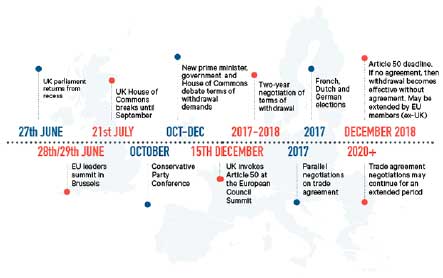The dust is settling. It has been a rollercoaster few weeks following the shock result of the UK referendum to leave the European Union – the political landscape has shifted, ratings agencies have downgraded outlooks and volatility has befallen the markets. However, the tsunami of news that has engulfed the UK recently has started to slow down, and with a new Prime Minister in place sooner than expected, there is now time to take stock of the result and start looking towards a future where the UK is no longer an EU member.
For the EU this was the worst possible outcome. AntiEU sentiment has been growing among some of its members for a number of years, and a Brexit will only compound the problem and promote this agenda. This will, in turn, perpetuate uncertainty around further exits from the membership and markets could suffer from prolonged volatility as a result.
It will be critical, therefore, to know exactly what the UK’s relationship with the EU will end up looking like. Not only might this deter other EU members from leaving (what the Commission is hoping) but also trade defines the wealth of a large number of countries and they will want to know whether the UK will still be part of the single market, or the EEA or have a free trade agreement similar to Canada. But whatever trade deal is agreed, it has been widely predicted this could take 2 years to negotiate – prolonged uncertainty.
Figure 1: Potential timeline for the UK’s exit

UK consumption has been hit since the Brexit result, but this is likely only in short term. In fact, according to the Brexit barometer — a Financial Times analysis of alternative economic indicators — day to day spending in the economy may have bounced back to just slightly below what it was immediately before the June 23 referendum. However, this won’t last forever, as it has been predicted the UK economy will shrink in 2016, and fall into recession by 2017.
Naturally the Bank of England has intervened since the UK decided to leave the EU and as expected, on the 4th of August it slashed interest rates by 0.25% and announced billions of pounds of stimulus to cushion the economic shock. This should ease some of the negative growth forecast, and help households through the tougher months ahead. “By acting early and comprehensively, the (Bank) can reduce uncertainty, bolster confidence, blunt the slowdown and support the necessary adjustments in the UK economy,” BoE Governor Mark Carney told a news conference.
For investors, this is a treacherous time in which to do business, but there are still opportunities to secure returns when market volatility is high. Fixed income bonds each come with their own risks, but they have long been seen uncorrelated and less risky when compared to equities and offer a fixed rate of return over a set period. They also provide portfolio diversification, a steady stream of income that acts as a cushion against the ups and downs of the stock market.
The main challenge currently facing the bond market is the low interest rate environment, which increases the price of the bond and lowers the yield. As a result, investors seeking higher returns are forced to look at longer maturing bonds. However, this does not mean there aren’t exciting and innovative products out there at the moment, which still produce attractive uncorrelated returns.
Before deciding which bond(s) to choose, investors should consider their tolerance for risk, their investment goal (mortgage, school tuition etc.) and their overall mix of investable assets.
Overall Brexit has highlighted the fragile nature of international markets, but has thrown up interesting questions around how to make money over projected long periods of volatility. Fixed income bonds are one way forward, and given it is such a diverse market there will always be at least one product out there for everyone.
Source: British Business Group





